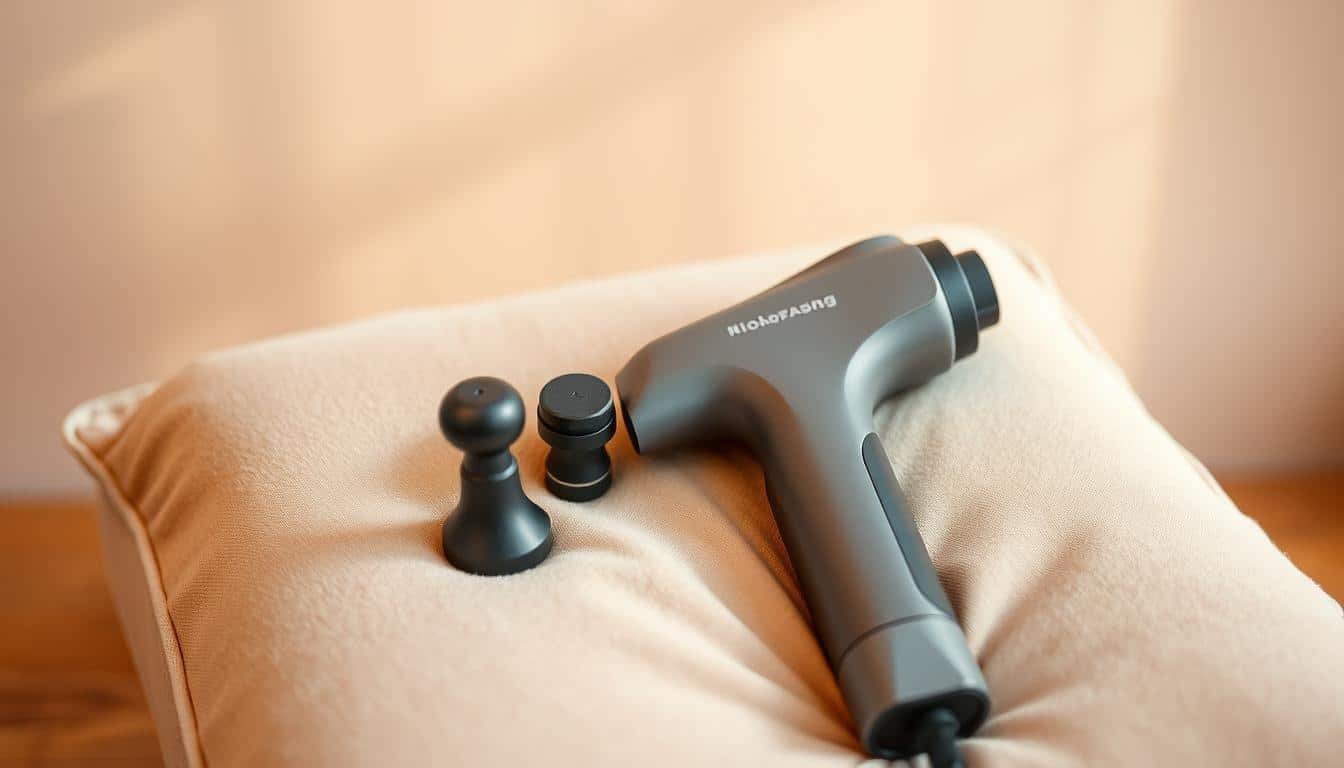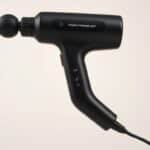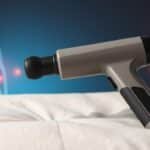Picture this: You’re halfway through your morning jog when that familiar twinge hits. Suddenly, bending down to tie your shoe feels like solving a Rubik’s Cube with your joints. Sound familiar? You’re not alone. Millions of Americans navigate this daily grind, where routine movements become tactical missions against discomfort.
Our bodies are like overworked office interns—constantly juggling demands without proper recovery. The complex network of muscles and tendons around your joints works overtime, especially when stiffness or soreness creeps in. That’s where modern recovery tools step in, offering more precision than your average foam roller and less drama than a chiropractor’s cracking soundtrack.
We’ve combed through research and real-world testing to cut through the noise. This isn’t about quick fixes or miracle cures. It’s about smarter recovery strategies that respect your body’s need for both power and pampering. Let’s face it—your joints deserve better than being treated like rusty door hinges.
Key Takeaways
- Understand common causes of joint discomfort through relatable scenarios
- Discover how targeted recovery tools complement natural healing processes
- Learn to balance scientific approaches with practical daily routines
- Set achievable goals for long-term mobility improvements
- Identify when professional guidance should accompany home care
Understanding Knee Pain: Causes and Impact
Your knees aren’t just joints—they’re the unsung heroes of every step, squat, and spontaneous dance move. When discomfort strikes, it’s like your body’s alarm system blaring “check engine” while you’re cruising through daily life. Let’s decode why this happens and what it means for your routine.
Identifying the Common Causes
The culprits behind joint troubles range from predictable to surprising. Excess weight acts like a backpack full of bricks—every 10 pounds adds 30-40 pounds of pressure during movement. High-impact sports? They’re boot camp for your joints without recovery time.
Top offenders include:
- Weekend warrior injuries from aggressive pick-up games
- Arthritis crashing the party like uninvited guests
- Muscle imbalances forcing joints to overcompensate
- Referred aches from rebellious hips or ankles
How Discomfort Reshapes Routines
Ordinary tasks become Olympic events overnight. Climbing stairs feels like scaling Everest. Playing with kids transforms into a tactical obstacle course. This isn’t just physical—it’s emotional theft, robbing people of joy-sparking activities.
The ripple effects include:
- Social plans getting canceled over standing-room venues
- Workout modifications (RIP, morning runs)
- Creative strategies for sitting/standing transitions
How Percussive Therapy Enhances Knee Health
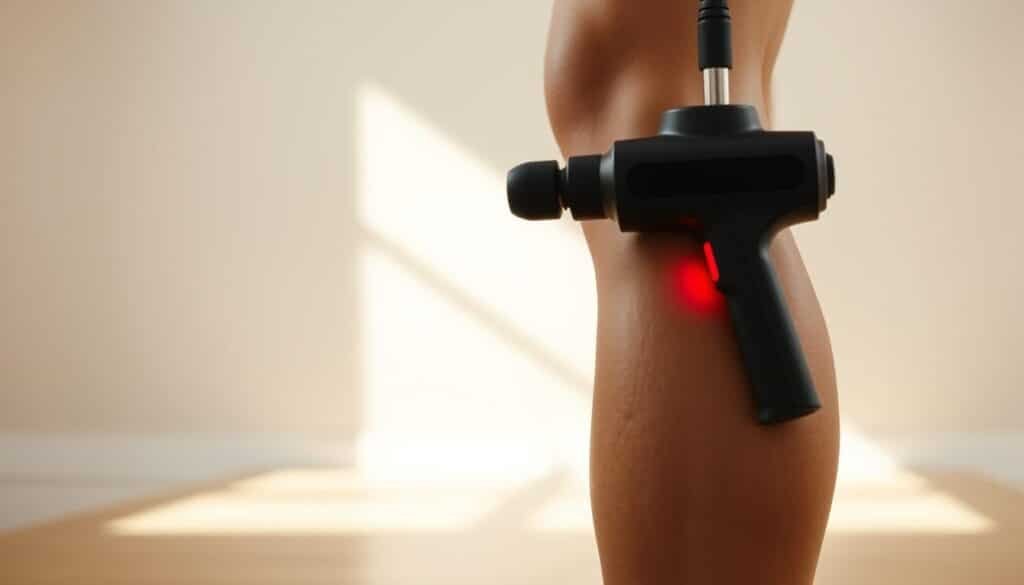
Imagine your muscles getting a high-tech tune-up—welcome to the world of percussive therapy. This approach uses rapid pulses to outsmart stubborn tension, like a locksmith picking your body’s natural recovery mechanisms. The secret lies in mechanical vibrations that work smarter, not harder.
The Science Behind Percussion Massage
Your nervous system plays bouncer to pain signals. Percussive devices knock out discomfort using gate control theory—flooding nerve pathways with vibrations until they forget to send “ouch” memos. Think of it as crowd control for your pain receptors.
These tools boost circulation like a turbocharged oil change. Oxygen-rich blood floods tired tissues while flushing lactic acid buildup. One physical therapist compares it to “power-washing metabolic waste from overworked cells.”
Benefits for Muscle Recovery and Range of Motion
Percussion’s magic unfolds in three key areas:
| Benefit | Mechanism | Outcome |
|---|---|---|
| Tissue Renewal | Breaks adhesions | Smoother movement |
| Nutrient Delivery | Enhances blood flow | Faster healing |
| Flexibility Boost | Relaxes tight fibers | Improved range motion |
Pair these techniques with proper application methods for maximum effect. Remember—your muscles crave rhythm, not punishment. Treat them to smart recovery, and they’ll return the favor with every step, squat, and spontaneous adventure.
Effective Use of massage gun for knee pain
Let’s get real about what these buzzing gadgets can (and can’t) do. While they’re fantastic for melting away tension in overworked muscles, they’re not time machines reversing years of wear. Think of them as your trusty co-pilot in mobility maintenance, not the mechanic rebuilding your engine.
Our strategy targets the real MVPs – the quads, hamstrings, and calves that secretly influence joint comfort. When these muscles tighten, they pull on connective tissues like overzealous puppeteers. A well-timed session with your percussion device acts like a diplomatic negotiator, easing strained relationships between muscle groups.
Here’s the truth bomb: three-minute daily sessions outperform marathon weekend beatdowns. Your tissues respond better to gentle persuasion than aggressive interrogation. Start with low-intensity pulses, gradually increasing pressure as your muscles whisper “thank you” instead of screaming “uncle!”
These tools shine brightest when paired with smart habits. Combine them with dynamic stretching or post-yoga cool downs, and suddenly you’re speaking your body’s love language. They’re particularly clutch for:
- Dissolving post-workout concrete legs
- Soothing stiffness from prolonged sitting
- Prepping muscles before activity
Remember – while your percussion ally tackles muscle-related discomfort, sharp or persistent aches demand professional backup. Use it as part of your wellness toolkit, not as a substitute for medical care. When used wisely, these devices help keep your movement game strong, one vibration at a time.
Step-by-Step Guide to Using Your Massage Gun
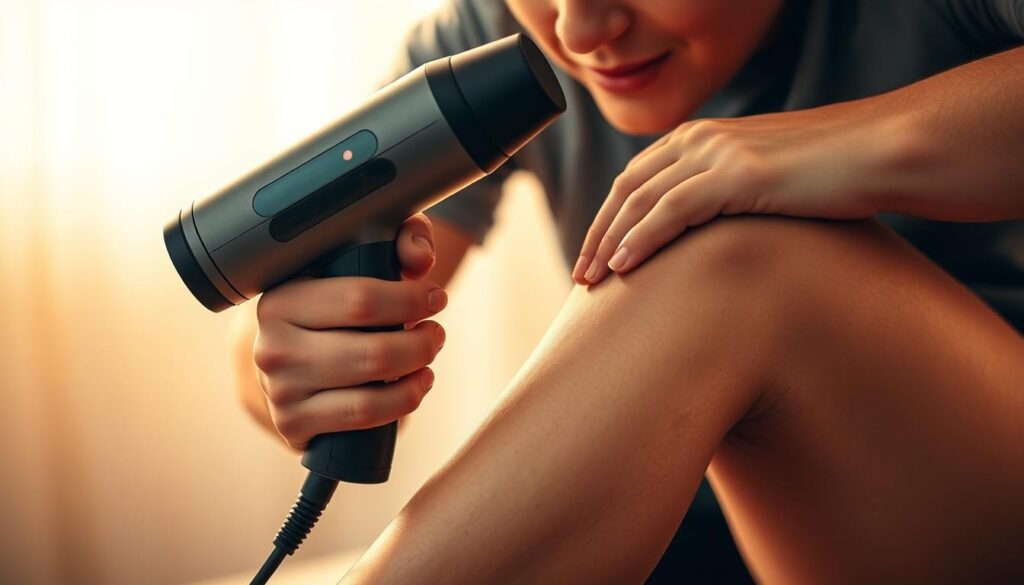
Mastering your device isn’t rocket science, but there’s an art to avoiding the “jackhammer meets jelly” effect. We’ll transform you from novice to ninja with clinical precision—no black belt required.
Power Settings and Pressure Playbook
Start low and slow like a cautious first date. Begin with circular motions around muscle groups, not joints. Our tested protocol:
| Attachment | Time per Zone | Best For |
|---|---|---|
| Flat head | 15-20 sec | Large muscle groups |
| Bullet tip | 10 sec max | Trigger points |
| Forked | 20 sec | Along tendons |
Physical therapists recommend 2-minute sessions per muscle group. If your face contorts like you’ve bitten a lemon, dial down the intensity. Discomfort means stop—not “power through.”
Safety First, Gains Second
Three golden rules separate pros from ER visitors:
- Never hover over bony areas—soft tissue only
- Keep movements fluid, like spreading peanut butter
- Pair with dynamic stretching for best results
Progress gradually: start with 2 weekly sessions before increasing frequency. Your body adapts slower than dial-up internet—respect its pace. When in doubt, consult a pro. Smart recovery beats reckless enthusiasm every time.
Targeting the Muscles Around the Knee
Navigating the terrain around your joints requires precision – think cartographer meets physical therapist. We’re plotting coordinates across four key regions that influence mobility more than your average GPS.
Quadriceps: Frontline Defenders
These thigh-mounted shock absorbers work overtime during every step. When they tighten, they pull kneecaps like overzealous puppeteers. Our approach? Glide your device vertically along muscle fibers, starting mid-thigh and moving toward the hip. Pro tip: Pause where tension peaks – these hotspots often hide in plain sight.
Hamstrings: Silent Contributors
The back-of-leg trio influences joint mechanics more than your Wi-Fi affects streaming quality. Target them seated or standing, using circular motions across the meaty middle section. One sports therapist notes: “Tight hamstrings yank pelvic alignment like bad posture at a keyboard marathon.”
Now let’s spotlight the supporting cast:
| Muscle Group | Technique | Duration |
|---|---|---|
| Inner Thigh | Horizontal strokes | 30 seconds/side |
| Calf | Upward pressure | 20 seconds/zone |
Three rules separate strategic care from random poking:
- Follow muscle grain like woodworkers follow oak rings
- Adjust pressure as if tuning a guitar – firm but forgiving
- Treat adjacent areas as interconnected systems
Remember: Your body’s symphony needs all sections playing in harmony. Address one sour note, and the whole composition improves.
Integrating Massage Gun Routines with Exercise

Think of your workout routine as a symphony—every element needs precise timing to create harmony. When percussion therapy meets physical activity, you’re conducting a masterpiece of muscle preparation and repair.
Pre-Workout Activation Protocol
Five minutes with your device can transform stiff tissues into responsive springs. Gentle pulses awaken dormant muscle fibers like sunlight hitting solar panels. A sports scientist explains: “Increased circulation delivers performance fuel while flushing out pre-existing tension.”
Optimal warm-up patterns:
| Muscle Group | Technique | Duration |
|---|---|---|
| Quadriceps | Vertical strokes | 90 seconds |
| Hamstrings | Circular motions | 60 seconds |
| Calves | Upward pressure | 45 seconds/side |
Post-Activation Recovery Boost
Post-exercise therapy acts like a reset button for overworked tissues. Research shows percussion devices reduce soreness by 40% compared to passive rest. The magic happens through three mechanisms:
- Oxygen-rich blood floods microtear repair zones
- Waste products get evicted faster than noisy hotel guests
- Neural pathways learn relaxed states more quickly
“Recovery isn’t downtime—it’s where growth happens. Smart tools accelerate cellular cleanup crews.”
Consistency matters more than intensity. Three weekly sessions yield better results than sporadic deep-tissue assaults. Pair with dynamic stretching for movement that flows like hot honey.
Safety Tips and Best Practices for Massage Gun Use
Safety first isn’t just a slogan—it’s your ticket to hassle-free recovery. These tools work best when treated like precision instruments, not blunt-force trauma devices. Let’s explore how to maximize benefits while keeping your body’s structural integrity intact.
Where Not to Point That Thing
Joints aren’t batting cages for percussive therapy. Surrounding tissues and ligaments react to vibrations like opera singers to off-key notes—poorly. Golden rule: Focus on muscles that support joints, not the joint itself. Research shows improper use increases injury risks by 23% compared to guided techniques.
Smart Use Playbook
Treat your device like a GPS for muscle recovery—it needs clear boundaries. Our field-tested guidelines:
- Red zones: Bruises, swelling, or areas warmer than a July sidewalk
- Green lights: Muscle bellies needing tension relief after activity
- Emergency brake: Stop if discomfort feels sharp rather than soothing
Post-surgery or blood thinners? Get medical clearance first. These tools complement professional treatment plans—they don’t replace them. When used wisely, they become your allies in maintaining mobility without unwanted drama.

